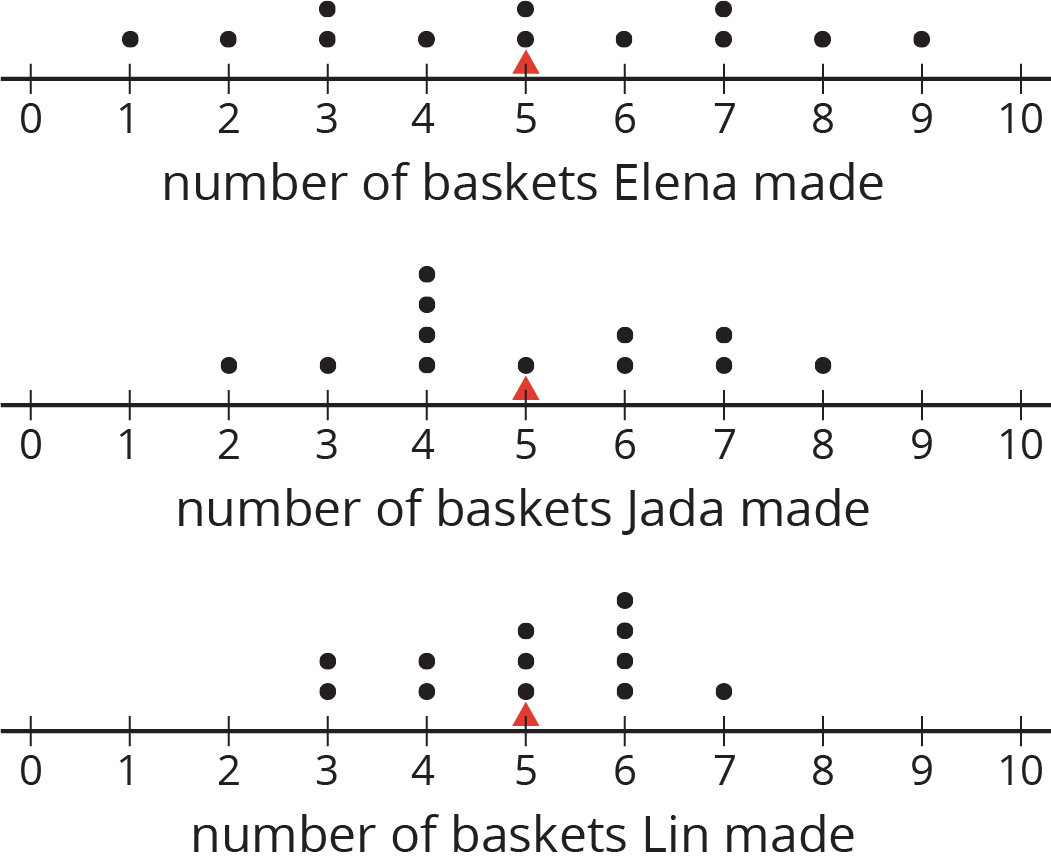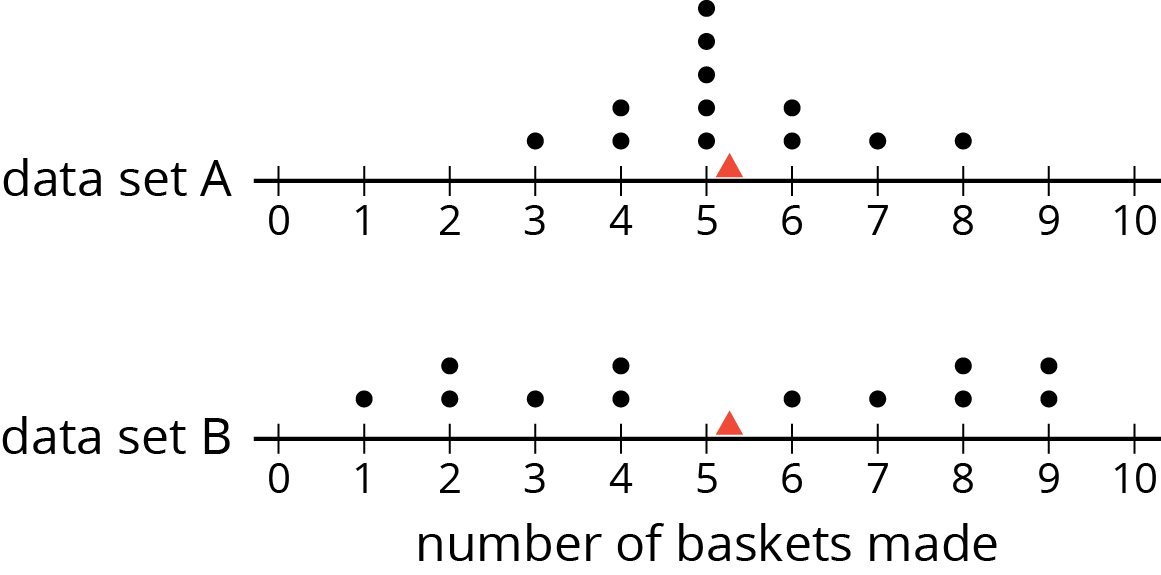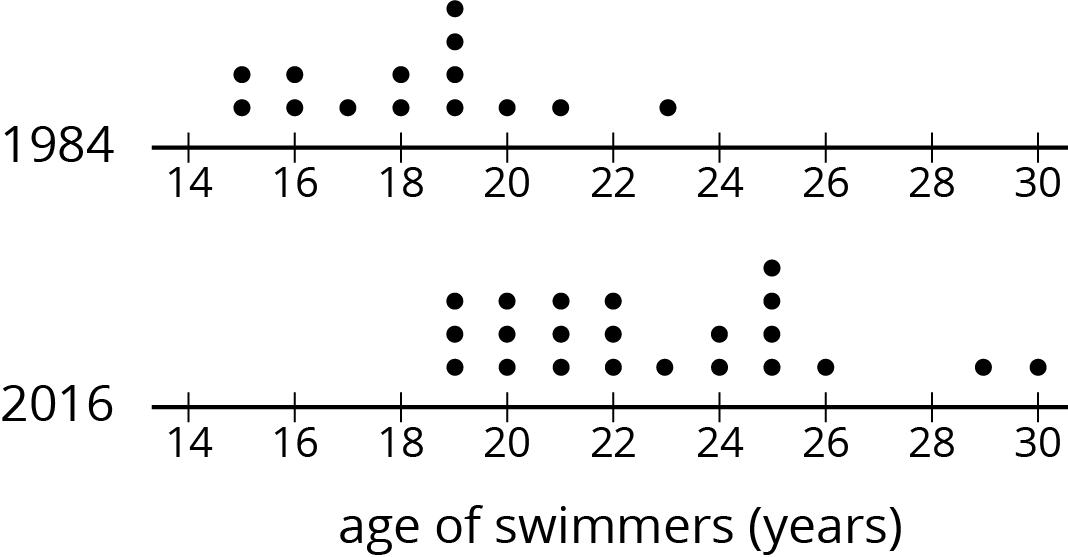Lesson 5
Variability and MAD
5.1: Shooting Hoops (Part 1) (5 minutes)
Warm-up
The purpose of this warm-up is for students to first reason about the mean of a data set without calculating and then practice calculating mean. The context will be used in an upcoming activity in this lesson so this warm-up familiarizes students with the context for talking about deviation from the mean.
In their predictions, students may think that Elena will have the highest mean, because she has a few very high scores (7, 8, and 9 points). They may also think that Lin and Jada will have very close means because they each have 5 higher scores than one another and their other scores are the same. Even though each player has the same mean, all of these ideas are reasonable things for students to consider when looking at the data. Record and display their predictions without further questions until they have calculated and compared the mean of their individual data sets.
Launch
Arrange students in groups of 3. Display the data sets for all to see. Ask students to predict which player has the largest mean and which has the smallest mean. Give students 1 minute of quiet think time and then poll students on the player who they think has the largest and smallest mean. Ask a few students to share their reasoning.
Tell each group member to calculate the mean of the data set for one player in the task, share their work in the small group, and complete the remaining questions.
Student Facing
Elena, Jada, and Lin enjoy playing basketball during recess. Lately, they have been practicing free throws. They record the number of baskets they make out of 10 attempts. Here are their data sets for 12 school days.
Elena
4
5
1
6
9
7
2
8
3
3
5
7
Jada
2
4
5
4
6
6
4
7
3
4
8
7
Lin
3
6
6
4
5
5
3
5
4
6
6
7
- Calculate the mean number of baskets each player made, and compare the means. What do you notice?
- What do the means tell us in this context?
Student Response
For access, consult one of our IM Certified Partners.
Activity Synthesis
Ask students to share the mean for each player's data set. Record and display their responses for all to see. After each student shares, ask the class if they agree or disagree and what the mean tells us in this context. If the idea that the means show that all three students make, on average, half of the 10 attempts to get the basketball in the hoop does not arise, make that idea explicit.
If there is time, consider revisiting the predictions and asking how the mean of Elena's data set can be the same as the others when she more high scores?
5.2: Shooting Hoops (Part 3) (15 minutes)
Activity
In the previous activity, students evaluated the performance of three students based on the mean and variability. Here they learn the term mean absolute deviation (MAD)as a way to quantify variability and calculate it by finding distances between the mean and each data value. Students compare data sets with the same mean but different MADs and interpret the variations in context.
While this process of calculating MAD involves taking the absolute value of the difference between each data point and the mean, this formal language is downplayed here. Instead, the idea of “finding the distance,” which is always positive, is used. This is done for a couple of reasons. One reason is to focus students' attention on the statistical work rather than on terminology or symbolic work. Another reason is that finding these differences may involve operations with signed numbers, which are not expected in grade 6.
The activity Shooting Hoops (Part 2) and the activity referred to in the launch are not included in IM 6–8 Math Accelerated.
During the launch, ask students what they think will be true about distances between data points and the mean, knowing that the mean can be considered a balance point. (The sum of the distances to the left of the mean is the same as the sum of the distances to the right of the mean.) Then tell students that the distances can also tell us something else about a distribution that will be explored in this activity.
Launch
Remind students in the last lesson they found distance between each data point and the mean, and found that the sum of those distances on the left and the sum on the right were equal, which allows us to think of the mean as the balancing point or the center of the data. Explain that the distance between each point and the mean can tell us something else about a distribution.
Arrange students in groups of 2. Give students 4–5 minutes to complete the first set of questions with their partner, and then 4–5 minutes of quiet time to complete the remaining questions. Follow with a whole-class discussion.
Student Facing
The tables show Elena, Jada, and Lin’s basketball data from an earlier activity. Recall that the mean of Elena’s data, as well as that of Jada and Lin’s data, was 5.
- Record the distance between each of Elena’s scores and the mean.
Elena 4 5 1 6 9 7 2 8 3 3 5 7 distance from 5 1 1 Now find the average of the distances in the table. Show your reasoning and round your answer to the nearest tenth.
This value is the mean absolute deviation (MAD) of Elena’s data.
Elena’s MAD: _________
- Find the mean absolute deviation of Jada’s data. Round it to the nearest tenth.
Jada 2 4 5 4 6 6 4 7 3 4 8 7 distance from 5 Jada’s MAD: _________
- Find the mean absolute deviation of Lin’s data. Round it to the nearest tenth.
Lin 3 6 6 4 5 5 3 5 4 6 6 7 distance from 5 Lin’s MAD: _________
-
Compare the MADs and dot plots of the three students’ data. Do you see a relationship between each student’s MAD and the distribution on her dot plot? Explain your reasoning.

Student Response
For access, consult one of our IM Certified Partners.
Student Facing
Are you ready for more?
Invent another data set that also has a mean of 5 but has a MAD greater than 2. Remember, the values in the data set must be whole numbers from 0 to 10.
Student Response
For access, consult one of our IM Certified Partners.
Anticipated Misconceptions
Students may recall the previous lesson about thinking of the mean as a balance point and think that the MAD should always be zero since the left and right distances should be equal. Remind them that distances are always positive, so finding the average of these distances to the mean can only be zero if all the data points are exactly at the mean.
Activity Synthesis
During discussion, highlight that finding how far away, on average, the data points are from the mean is a way to describe the variability of a distribution. Discuss:
- “What can we say about a data set whose data points have very small distances from the mean?”
- “What about a data set with points that show large distances from the mean?”
- “Does a data set with smaller distances (and therefore smaller average distances) show less or more variability?”
- “What do MAD values of 2, 1.5, and 1 mean in this context?”
Supports accessibility for: Memory; Language
Design Principle(s): Support sense-making
5.3: Which Player Would You Choose? (20 minutes)
Activity
This activity allows students to practice calculating MAD and build a better understanding of what it tells us. Students continue to compare data sets with the same mean but different MADs and interpret what these differences imply in the context of the situation.
Launch
Arrange students in groups of 3–4. Before students read the task statements, display the two dot plots in the task for all to see. Give students up to 1 minute to study the dot plots and share with their group what they notice and wonder about the plots.

Next, select a few students to share their observations and questions; it is not necessary to confirm or correct students' observations or answer their questions at this point. If no one noticed or wondered about what variable the data sets show, ask students what they think the context for the data sets might be or what quantities they show. Explain to students that they will find more information in the task statement to help them compare and interpret the dot plots.
Give students 3–4 minutes of quiet work time to complete the first set of questions, and then 8–10 minutes to complete the second set with their group. Allow at least a few minutes for a whole-class discussion.
Supports accessibility for: Memory; Conceptual processing
Student Facing
-
Andre and Noah joined Elena, Jada, and Lin in recording their basketball scores. They all recorded their scores in the same way: the number of baskets made out of 10 attempts. Each collected 12 data points.
- Andre’s mean number of baskets was 5.25, and his MAD was 2.6.
- Noah’s mean number of baskets was also 5.25, but his MAD was 1.
Here are two dot plots that represent the two data sets. The triangle indicates the location of the mean.
- Without calculating, decide which dot plot represents Andre’s data and which represents Noah’s. Explain how you know.
- If you were the captain of a basketball team and could use one more player on your team, would you choose Andre or Noah? Explain your reasoning.
- An eighth-grade student decided to join Andre and Noah and kept track of his scores. His data set is shown here. The mean number of baskets he made is 6.
eighth‐grade student 6 5 4 7 6 5 7 8 5 6 5 8 distance from 6 - Calculate the MAD. Show your reasoning.
- Draw a dot plot to represent his data and mark the location of the mean with a triangle (\(\Delta\)).
- Compare the eighth-grade student’s mean and MAD to Noah’s mean and MAD. What do you notice?
- Compare their dot plots. What do you notice about the distributions?
- What can you say about the two players’ shooting accuracy and consistency?
Student Response
For access, consult one of our IM Certified Partners.
Student Facing
Are you ready for more?
Invent a data set with a mean of 7 and a MAD of 1.
Student Response
For access, consult one of our IM Certified Partners.
Activity Synthesis
Select a couple of students to share their responses to the first set of questions about how they matched the dot plots to the players (Andre and Noah) and how they knew.
Then, display a completed table and the MAD for the second set of questions. Give students a moment to check their work. To facilitate discussion, help students connect MAD and the spread of data, and enable them to make comparison, consider displaying all three dot plots at the same scale and using a line segment to represent the MAD on each dot plot, as shown here.

Invite a few students to share their observations about how the means and MADs of Noah and the eighth-grade student compare. Discuss:
- “How are the distributions of points related to the mean? How are they related to the MAD?”
- “Which might be more desirable for a basketball team: a lower mean or a higher mean? Why?”
- “Which might be more desirable: a lower MAD or a higher MAD? Why?”
- “Of the three students, which one would you want on your team? Why?”
Expect students to choose different players to be on their team, but be sure they support their preferences with a reasonable explanation (MP3). Students should walk away understanding that, in this context, a higher MAD indicates more variability and less consistency in the number of shots made.
Design Principle(s): Support sense-making
5.4: Swimmers Over the Years (10 minutes)
Activity
In this activity, students continue to practice interpreting the mean and the MAD and to use them to answer statistical questions. A new context is introduced, but students should continue to consider both the center and variability of the distribution as ways of thinking about what is typical for a set of data and how consistent the data tends to be.
Launch
Give students 5–7 minutes of quiet work time. Ask students to consider drawing a triangle and a line segment on each dot plot in the last question to represent the mean and MAD for each data set (as was done in an earlier lesson).
Student Facing
In 1984, the mean age of swimmers on the U.S. women’s swimming team was 18.2 years and the MAD was 2.2 years. In 2016, the mean age of the swimmers was 22.8 years, and the MAD was 3 years.
- How has the average age of the women on the U.S. swimming team changed from 1984 to 2016? Explain your reasoning.
- Are the swimmers on the 1984 team closer in age to one another than the swimmers on the 2016 team are to one another? Explain your reasoning.
-
Here are dot plots showing the ages of the women on the U.S. swimming team in 1984 and in 2016. Use them to make two other comments about how the women’s swimming team has changed over the years.

Student Response
For access, consult one of our IM Certified Partners.
Activity Synthesis
Have a student display dot plots with the means and MADs marked on them. Invite several students to share their comments about how the composition of the swimming team has changed over the three decades. Some discussion questions:
- “What can you say about the size of the team? Has it changed?”
- “Overall, has the team gotten older, younger, or stayed about the same? How do you know?”
- “Has the age of the youngest swimmer changed? What about the age of the oldest swimmer?”
- “Has the team become more diverse in ages, in general? Or have the swimmers become more alike in their age? How do you know?”
Students should recognize that the higher mean and MAD for the 2016 swimming team tell us that the team, on the whole, has gotten older and more diverse in ages. In 1984, 18.2 years was a typical age for the swimmers. A typical age for the 2016 swimmers was 22.8 years and there was a wider range of ages represented.
Design Principle(s): Support sense-making; Optimize output (for explanation)
Lesson Synthesis
Lesson Synthesis
In an earlier lesson, we learned that the mean can tell us about what is typical for (or what is characteristic of) a data set because it measures the center of a distribution. In this lesson, we learn that we can also use a measure of spread to tell us about how much the values in a data set vary.
- “What does the MAD tell us?” (The average distance between data points and the mean. It tells us how spread out the data values are.)
- “How do we find the MAD?” (Find the distance between each data point and the mean. Add all the distances and divide by the number of data points.)
- “How is MAD related to the variability of a data set?” (The greater the value of the MAD, the more spread out the data are. Smaller values of the MAD means the data values are closer together.)
- “Suppose the mean height of the students in a class is 60 inches and the MAD is 2.5 inches. How do the mean and the MAD tell us about what is typical for the students' heights?” (Students in the class are typically around 60 inches tall and within about 2.5 inches of that height.)
5.5: Cool-down - Travel Times Across the World (5 minutes)
Cool-Down
For access, consult one of our IM Certified Partners.
Student Lesson Summary
Student Facing
We use the mean of a data set as a measure of center of its distribution, but two data sets with the same mean could have very different distributions.
This dot plot shows the weights, in grams, of 22 cookies.

The mean weight is 21 grams. All the weights are within 3 grams of the mean, and most of them are even closer. These cookies are all fairly close in weight.
This dot plot shows the weights, in grams, of a different set of 30 cookies.

The mean weight for this set of cookies is also 21 grams, but some cookies are half that weight and others are one-and-a-half times that weight. There is a lot more variability in the weight.
There is a number we can use to describe how far away, or how spread out, data points generally are from the mean. This measure of spread is called the mean absolute deviation (MAD).
Here the MAD tells us how far cookie weights typically are from 21 grams. To find the MAD, we find the distance between each data value and the mean, and then calculate the mean of those distances.
For instance, the point that represents 18 grams is 3 units away from the mean of 21 grams. We can find the distance between each point and the mean of 21 grams and organize the distances into a table, as shown.

| weight in grams | 18 | 19 | 19 | 19 | 20 | 20 | 20 | 20 | 21 | 21 | 21 | 21 | 21 | 22 | 22 | 22 | 22 | 22 | 22 | 23 | 23 | 24 |
|---|---|---|---|---|---|---|---|---|---|---|---|---|---|---|---|---|---|---|---|---|---|---|
| distance from mean | 3 | 2 | 2 | 2 | 1 | 1 | 1 | 1 | 0 | 0 | 0 | 0 | 0 | 1 | 1 | 1 | 1 | 1 | 1 | 2 | 2 | 3 |
The values in the first row of the table are the cookie weights for the first set of cookies. Their mean, 21 grams, is the mean of the cookie weights.
The values in the second row of the table are the distances between the values in the first row and 21. The mean of these distances is the MAD of the cookie weights.
What can we learn from the averages of these distances once they are calculated?
- In the first set of cookies, the distances are all between 0 and 3. The MAD is 1.2 grams, which tells us that the cookie weights are typically within 1.2 grams of 21 grams. We could say that a typical cookie weighs between 19.8 and 22.2 grams.
-
In the second set of cookies, the distances are all between 0 and 13. The MAD is 5.6 grams, which tells us that the cookie weights are typically within 5.6 grams of 21 grams. We could say a typical cookie weighs between 15.4 and 26.6 grams.
The MAD is also called a measure of the variability of the distribution. In these examples, it is easy to see that a higher MAD suggests a distribution that is more spread out, showing more variability.